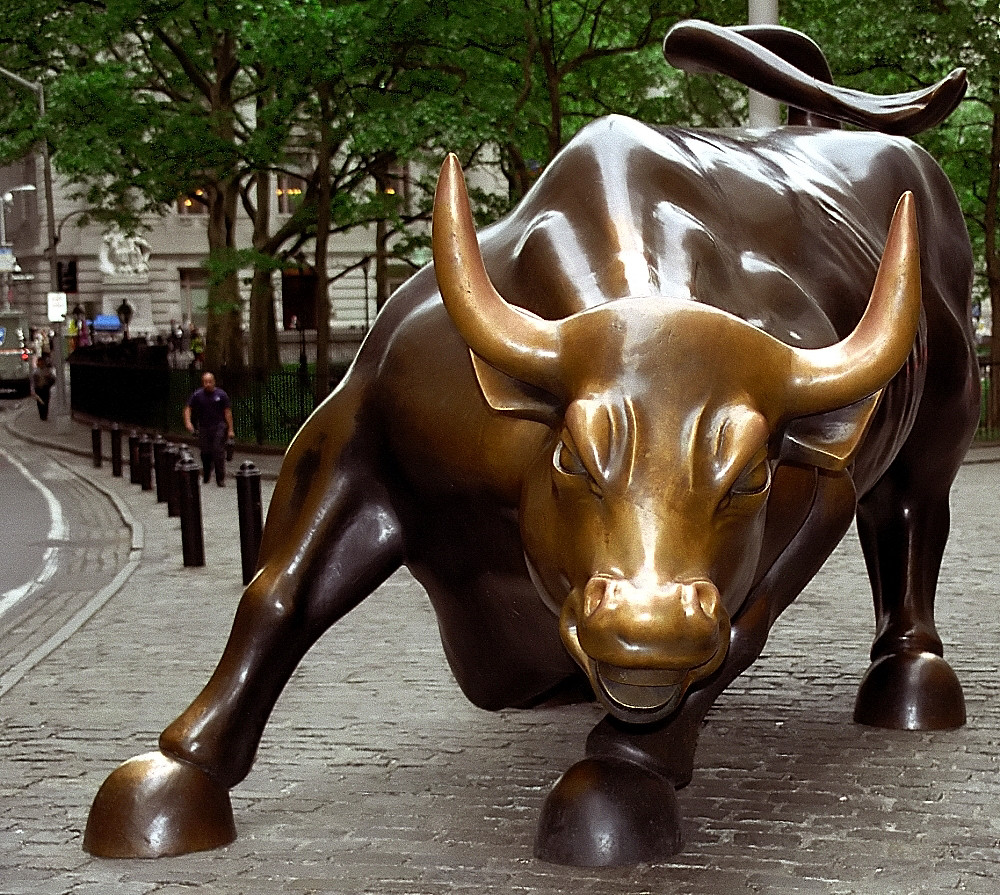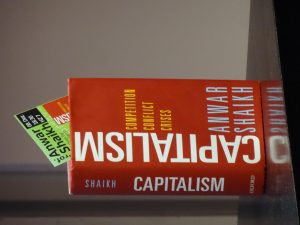Milton's Myth #4: Free Enterprise Reduces Discrimination
✑ ROBIN HAHNEL | ± 5 minutes
Mainstream economists say firms that discriminate will be competed out of business. But profit maximizing firms in fact require economic discrimination. (All of Milton's myths here).
Discrimination in hiring, assignment, promotion, and payment have all been used to aggravate suspicions and antagonisms that already exist between people of different races and ethnic backgrounds as well as between men and women, and people with different sexual preferences. Historical settings where ample reasons for suspicion and mistrust already exist provide ready-made pressure points employers can manipulate to “divide and conquer” their employees. When employees are mutually suspicious they can be more easily induced to inform on one another regarding lackadaisical efforts – making it easier for the employer to extract more “labor done” from the “labor hired.” When employees are unsupportive of one another they will be easier for their employer to bargain with over wages when their contract comes up. What the conflict theory reveals is that since discriminatory practices by an individual employer have these positive effects on profits, profit maximization requires engaging in discriminatory practices up to the point where the negative effects of discrimination on profits – which are the exclusive focus of mainstream theory – outweigh the profit-enhancing effects – which only political economists identify. In other words, competition for profits will drive employers to engage in discriminatory practices up to the point where the redistributive effect of discrimination – increasing the employer’s share of value added by decreasing employees’ bargaining power – equals the negative impact of discrimination on productivity or the wage bill.
The increasingly popular view in the US that government protection and affirmative action have done their job and are no longer necessary could not be farther from the truth.2 As the government’s anti-discriminatory efforts weakened, the discrepancy between the wages of equivalent black and white workers increased by 50% from 10.9% in 1979 to 16.4% in 1989.3 A study by the Government Accounting Office released in January 2002 revealed that the female wage gap was no longer shrinking, but had widened significantly between 1995 and 2000. Shannon Henry reported in an article titled “Male-Female Salary Gap Growing, Study Says” published in The Washington Post on January 24, 2002:
The conflict theory merely explains what is readily apparent to anyone who wishes to see.
This article is part of a list of refutations of ideas from Milton Friedman and mainstream economists in Robin Hahnel's book 'The ABC's of Political Economy' (2014). See all other myths already published on Socialist Economist here.
NOTES
1 See Michael Reich, Racial Inequality (Princeton University Press, 1981): 204–215 for a simple, yet powerful model proving that wage discrimination is a necessary condition for profit maximization for individual capitalist employers operating in competitive markets.
2 See Barbara Bergman, In Defense of Affirmative Action (Basic Books, 1996) for persuasive evidence that affirmative action programs do help groups that are discriminated against, and that discrimination quickly reappears in their absence.
3 Lawrence Mishel and Jared Bernstein, The State of Working America: 1994–95 (M.E. Sharpe, 1994): 187. “Equivalent” means comparing black and white workers with the same level of education, work experience, etc.
‟It is foolish to wait for capitalism to eliminate discrimination.
Mainstream economists say firms that discriminate will be competed out of business. But profit maximizing firms in fact require economic discrimination. (All of Milton's myths here).
Originally published in chapter ten of Hahnel's book The ABC's of Political Economy: A Modern Approach (Pluto Press, 2014).
|
|---|
About the author (click)
Robin Eric Hahnel (1946) is Professor Emeritus of Economics at American University in Washington DC. He has published on marxian economics, liberating theory, economic crises , ecological issues and “participatory economics”. He has frequently contributed to Znet and is the co-director of Economics for Equity and the Environment.
General introduction (click)
This article is part of a series refuting several myths of the neoliberal economist Milton Friedman (1912-2006), extracted from the book ABC's of Political Economy: A Modern Approach (Pluto Press, 2014) by economist Robin Hahnel. The general introduction was included in the first post of this series but can also be found here below↴
When Milton Friedman published Capitalism and Freedom (University of Chicago Press) in 1964 free market capitalism was not yet ascendant. In the post WWII era Keynesian, social democratic capitalism was more dominant, and government regulation and guidance of the economy was generally considered necessary, prudent, and desirable. So Friedman was writing as a dissident when he argued that only free market capitalism can provide economic freedom, promote political liberty, allocate resources efficiently, motivate people successfully, and reward people fairly, and government intervention was usually unnecessary and counterproductive.
By 2002 when the first edition of The ABCs of Political Economy was published neoliberal capitalism stood triumphant over the demise of not only centrally planned Communism, but social democratic, Keynesian capitalism as well. Friedman’s disciples were more confident than ever that free market capitalism was the best economy possible. Deregulation, privatization, and dismantling the social safety net had become the order of the day. Keynesians had been successfully isolated and silenced, and only a scattered tribe of “heterodox economists” any longer challenged Milton Friedman’s claims about the virtues of free market capitalism.
What a difference twelve years can make! While neoliberal capitalism still clings to power almost everywhere in 2014, and especially within the economics profession, there are now many who doubt that free market capitalism is truly the best economic system for the vast majority. Six years after the worst financial crash in four generations the global financial system remains without adequate regulation, and is just as dangerous as it was before the collapse of Lehman Bros. Five years after the largest drop in GDP since the Great Depression unemployment remains high in all the advanced economies with no end in sight. And despite overwhelming evidence that we are on course to unleash disastrous climate change, carbon emissions continue to rise everywhere. While the tongues of all but a few critics were tied in 2002, there are now many voices bemoaning the loss of hard won reforms neoliberals assured us were counterproductive, no longer necessary, or unaffordable. Every day more people are realizing that we are on course for an ecological disaster of Biblical proportions. As our “old economies” continue to fail us, there is rising interest in a potpourri of initiatives that are self-consciously not business-as-usual economics, called the “new” or “future” economy. And finally, there is a notable stirring of renewed interest in alternatives to capitalism altogether. However, it is still instructive to begin a careful evaluation of free market capitalism with a point-by-point response to Milton Friedman’s claims about its purported virtues that have grown to become popular myths about capitalism. After which we can see where criticisms raised by protest movements in Europe and the US during the past five years fit into the long, historic debate over the pros and cons of laissez faire capitalism.
When Milton Friedman published Capitalism and Freedom (University of Chicago Press) in 1964 free market capitalism was not yet ascendant. In the post WWII era Keynesian, social democratic capitalism was more dominant, and government regulation and guidance of the economy was generally considered necessary, prudent, and desirable. So Friedman was writing as a dissident when he argued that only free market capitalism can provide economic freedom, promote political liberty, allocate resources efficiently, motivate people successfully, and reward people fairly, and government intervention was usually unnecessary and counterproductive.
By 2002 when the first edition of The ABCs of Political Economy was published neoliberal capitalism stood triumphant over the demise of not only centrally planned Communism, but social democratic, Keynesian capitalism as well. Friedman’s disciples were more confident than ever that free market capitalism was the best economy possible. Deregulation, privatization, and dismantling the social safety net had become the order of the day. Keynesians had been successfully isolated and silenced, and only a scattered tribe of “heterodox economists” any longer challenged Milton Friedman’s claims about the virtues of free market capitalism.
What a difference twelve years can make! While neoliberal capitalism still clings to power almost everywhere in 2014, and especially within the economics profession, there are now many who doubt that free market capitalism is truly the best economic system for the vast majority. Six years after the worst financial crash in four generations the global financial system remains without adequate regulation, and is just as dangerous as it was before the collapse of Lehman Bros. Five years after the largest drop in GDP since the Great Depression unemployment remains high in all the advanced economies with no end in sight. And despite overwhelming evidence that we are on course to unleash disastrous climate change, carbon emissions continue to rise everywhere. While the tongues of all but a few critics were tied in 2002, there are now many voices bemoaning the loss of hard won reforms neoliberals assured us were counterproductive, no longer necessary, or unaffordable. Every day more people are realizing that we are on course for an ecological disaster of Biblical proportions. As our “old economies” continue to fail us, there is rising interest in a potpourri of initiatives that are self-consciously not business-as-usual economics, called the “new” or “future” economy. And finally, there is a notable stirring of renewed interest in alternatives to capitalism altogether. However, it is still instructive to begin a careful evaluation of free market capitalism with a point-by-point response to Milton Friedman’s claims about its purported virtues that have grown to become popular myths about capitalism. After which we can see where criticisms raised by protest movements in Europe and the US during the past five years fit into the long, historic debate over the pros and cons of laissez faire capitalism.
M
ainstream economists insist that competition for profits among employers will reduce discrimination. They point out that if an employer has “a taste” for discrimination and insists on paying white employees more than equivalent black employees, or male employees more than equivalent female employees, the discriminating employer will have a higher wage bill than an employer who does not discriminate and pays equivalent employees equally. Mainstream theorists conclude that eventually employers who do not discriminate should compete those who do out of business. Similarly, they point out that the business of any employer who fails to hire or promote the most qualified people due to overt or unconscious discrimination will be less productive than businesses who hire and promote purely on merit. So according to mainstream economists a firm that engages in discriminatory hiring or promotion practices should also be competed out of business by firms that do not. While mainstream theory is quick to see the profit-reducing aspects of economic discrimination on the part of employers, it is blind to the profit-increasing effects of discrimination. By recognizing the importance of bargaining power in the ongoing struggle between employers and their employees over the distribution of value added, the conflict theory of the firm helps us see why profit maximization does not preclude, but in fact requires, economic discrimination even when employers operate in competitive labor, goods, and capital markets. |
| Milton Friedman + graph (see Related-box below) |
Discrimination in hiring, assignment, promotion, and payment have all been used to aggravate suspicions and antagonisms that already exist between people of different races and ethnic backgrounds as well as between men and women, and people with different sexual preferences. Historical settings where ample reasons for suspicion and mistrust already exist provide ready-made pressure points employers can manipulate to “divide and conquer” their employees. When employees are mutually suspicious they can be more easily induced to inform on one another regarding lackadaisical efforts – making it easier for the employer to extract more “labor done” from the “labor hired.” When employees are unsupportive of one another they will be easier for their employer to bargain with over wages when their contract comes up. What the conflict theory reveals is that since discriminatory practices by an individual employer have these positive effects on profits, profit maximization requires engaging in discriminatory practices up to the point where the negative effects of discrimination on profits – which are the exclusive focus of mainstream theory – outweigh the profit-enhancing effects – which only political economists identify. In other words, competition for profits will drive employers to engage in discriminatory practices up to the point where the redistributive effect of discrimination – increasing the employer’s share of value added by decreasing employees’ bargaining power – equals the negative impact of discrimination on productivity or the wage bill.
‟Historical settings where ample reasons for suspicion and mistrust already exist provide ready-made pressure points employers can manipulate to “divide and conquer” their employees.The implications of discovering that economic discrimination is part and parcel of profit maximization are enormous. First, since mainstream theorists are correct that discrimination often reduces economic efficiency, it provides yet another reason to believe that capitalism will not be efficient. But more importantly this means that it is not the employers who discriminate who will eventually be driven out of business by those who do not, but just the reverse. Employers who steadfastly refuse to discriminate will be driven out of business by those who pay attention only to the bottom line – and therefore engage in profit-enhancing discriminatory behavior. The implication for public policy is huge. If mainstream economists were correct, competitive labor, goods, and capital markets would tend to eliminate discriminatory employment practices, at least in the long run. In which case, if minorities and women were willing to continue to pay the price for society’s patience, we could expect discrimination to diminish without government involvement. But the conflict theory demonstrates that even assuming no collusion among employers, it is profitable for individual employers to aggravate racial antagonisms among their employees up to the point where the costs of doing so outweigh the additional profits that come from negotiating with a less powerful group of employees. Therefore it is foolish to wait for capitalism to eliminate discrimination if unaided. Instead, laws outlawing discrimination and affirmative action programs are absolutely necessary if discrimination is to be reduced in capitalist economies. Moreover, the struggle against discrimination through active intervention must constantly “swim upstream” in capitalism because employers who do discriminate are rewarded with higher profits, and employers who refuse to discriminate are punished by shareholders who care only about their bottom line.1
The increasingly popular view in the US that government protection and affirmative action have done their job and are no longer necessary could not be farther from the truth.2 As the government’s anti-discriminatory efforts weakened, the discrepancy between the wages of equivalent black and white workers increased by 50% from 10.9% in 1979 to 16.4% in 1989.3 A study by the Government Accounting Office released in January 2002 revealed that the female wage gap was no longer shrinking, but had widened significantly between 1995 and 2000. Shannon Henry reported in an article titled “Male-Female Salary Gap Growing, Study Says” published in The Washington Post on January 24, 2002:
Female managers are not only making less money than men in many industries, but the wage gap widened during the economic boom years of 1995 to 2000, according to a congressional study to be released today. The study found that a full-time female communications manager earned 86 cents for every dollar a male made in her industry in 1995. In 2000, she made only 73 cents of the man’s dollar.
The conflict theory merely explains what is readily apparent to anyone who wishes to see.
| Related: The latest report from the U.S. Census Bureau (Income and Poverty in the United States: 2017) shows real median household income by "race and hispanic origin" over the last fifty years:
|
|---|
This article is part of a list of refutations of ideas from Milton Friedman and mainstream economists in Robin Hahnel's book 'The ABC's of Political Economy' (2014). See all other myths already published on Socialist Economist here.
NOTES
1 See Michael Reich, Racial Inequality (Princeton University Press, 1981): 204–215 for a simple, yet powerful model proving that wage discrimination is a necessary condition for profit maximization for individual capitalist employers operating in competitive markets.
2 See Barbara Bergman, In Defense of Affirmative Action (Basic Books, 1996) for persuasive evidence that affirmative action programs do help groups that are discriminated against, and that discrimination quickly reappears in their absence.
3 Lawrence Mishel and Jared Bernstein, The State of Working America: 1994–95 (M.E. Sharpe, 1994): 187. “Equivalent” means comparing black and white workers with the same level of education, work experience, etc.
























Comments
Post a Comment
Your thoughts...